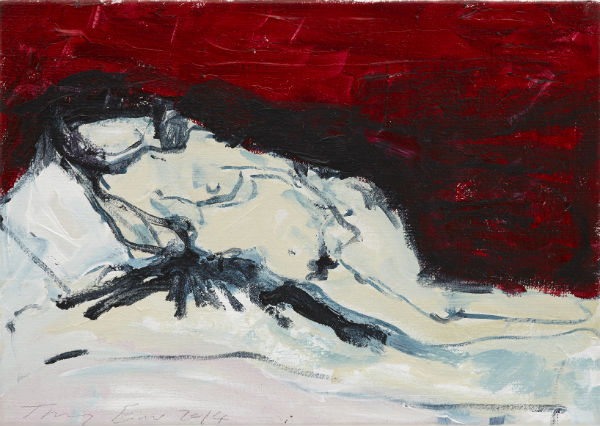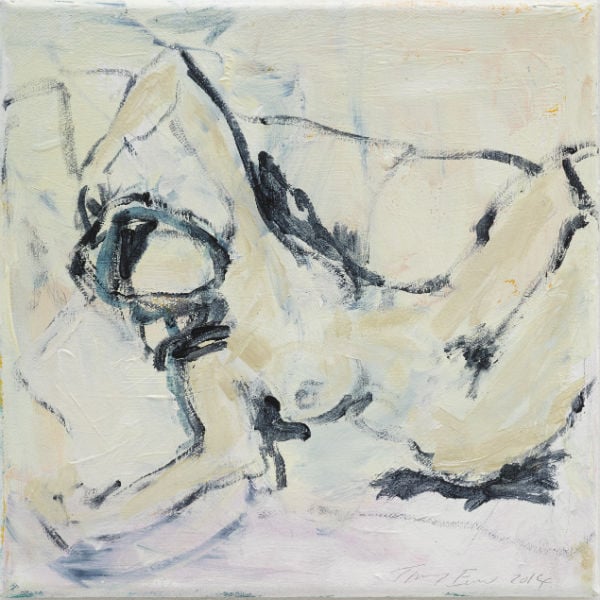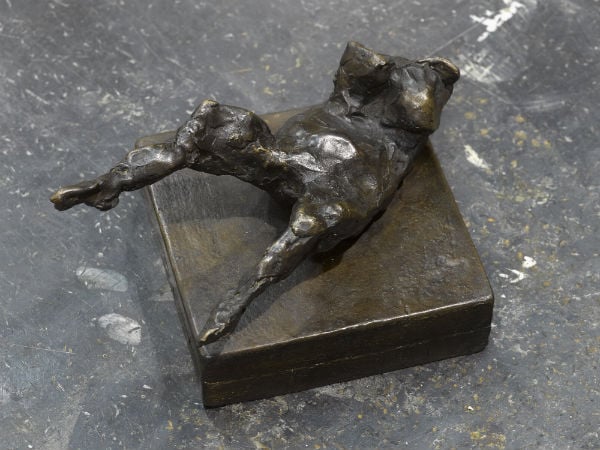Art & Exhibitions
Tracey Emin’s Dejection Is Becoming Too Predictable
White Cube show begs the question: Is she still at the vanguard of contemporary art?

White Cube show begs the question: Is she still at the vanguard of contemporary art?

JJ Charlesworth

The female figure, reclining awkwardly on her side or on her back, dominates Tracey Emin’s solo show “The Last Great Adventure is You,” her first at White Cube in five years. It’s there in the run of swift gouache life studies, in the series of small, layered oil paintings, and everywhere in a host of editioned bronze sculptures. A female body forever slumped and fragmented, the head blacked out in the drawings and paintings, or entirely missing in the sculptures—which are often no more than torsos, the legs and arms half-absent. Only breasts and genitals resist the stripping away. These are the nonnegotiable signs of being female.
They’re meant as mirrors of emotional states, of course, and the states Emin is most often intent on expressing are suffering and reconciliation. Her modus operandi is the pain of living emotions intensely in and via a physical body, and giving in to loss to the point of collapse, all while hoping for some kind of redemption, or, at least, a bit of peace.
“More Solitude,” wishes one bright, bare, neon wall-script. Emin has rehearsed this script for existence for years now, and “The Last Great Adventure is You” swings from crisis to serenity with the predictability of a pendulum, though the emphasis is perhaps now on the serenity.

Tracey Emin, Good Body (2014)
© Tracey Emin. All rights reserved, DACS 2014
Photo: Ben Westoby, courtesy White Cube
Maybe Emin is happier with herself. Certainly the 30 or so gouaches of a recumbent or sitting figure are relaxed and unforced, lightly expressionistic notations of a body at rest or calmly attentive to itself. But they’re technically slight, and, without the biographical branding that Emin brings to everything, they barely signify more than a million similar life-room sketches by countless other diligent students.
At every turn of this exhibition, it’s the insistence, the dominance, of the artist’s emotional narrative that underwrites the insubstantiality of what’s explored visually. The little bronze torsos lie back in various ways, but they’re really just little icons, repeating the same idea of placid resignation. They’re neither good nor bad as sculptures, because they’re part of a catalogue of motifs that Emin has settled as uniformly representative of her particular kind of ecstatic dejection. But there’s a strange lack of a sense of exploration, of discovery, in these, as if the possibility of letting the medium produce something unintended would run the risk of straying too far off-message from the Emin signature.
That’s most obviously the case in the sentimental iconography of the more symbolic sculptures: A little figure clings child-like to the back of a bird in flight (Take Me Home, 2014); a tiny bird perches atop a tall tree stump (I Love You, 2014); a small headless figure sits inside a little arched grotto.
They have all the tenderness of children’s book illustrations or gift shop ornaments, and it’s easy to feel gently comforted by their rhetoric of resilient fragility; but, again, they’re icons, not experiments towards other ways of giving shape to feeling and a sense of self.

Tracey Emin, Wanting (2014)
© Tracey Emin All rights reserved, DACS 2014
Photo: Ben Westoby, courtesy White Cube
Given the quantity of works on offer here, maybe there’s no room for too much experiment. After all, there are different product lines to be supplied for a market hungry for the badges of Emin’s authenticity. However, there are interesting, wild exceptions to this, in the almost indecipherable gestural chaos of the painting Devoured by You (2014) and particularly in the opposing sculptures The Lamb (2014) and Lion Love (2014). The Lamb could have been an essay in cuteness, but it sits with slanted eyes in a pose that reeks of regal, almost sinister, confidence, like some Old Testament idol. By contrast, Lion Love takes the king of beasts and shrinks him down to a domestic, thoughtful little creature, front paws folded under his chin. With their plinths inscribed with uncharacteristically enigmatic texts, this duo somehow manage to make real Emin’s manifesto of triumph-through-vulnerability, with an austere precision of regard for the particularity of visual form and physical gesture that is lacking elsewhere.
The problem is that Emin really does know her art moves; she alludes to Rodin, Giacometti, Richier, Twombly, to name but a few. And, yet, too often the systematic, formal intensity of those artists echoes like bits of music sampled. They are as sources of authority borrowed, but never absorbed, and thus are not made over into something aesthetically new. They are never actually Emin’s own. Instead, they’re present as signifiers of an ideal of self-expression that, in the end, remains a form of quotation.
Still, one has to wonder if too much stylistic invention would run counter to Emin’s dogged commitment to an unsullied ideal—or maybe in truth it’s the unattainable fantasy—of a pure, unmediated directness of expression, in which one’s inner world could always happily, miraculously, find its perfect embodiment in material form.
JJ Charlesworth is a freelance critic and associate editor at ArtReview magazine. Follow @jjcharlesworth on Twitter.